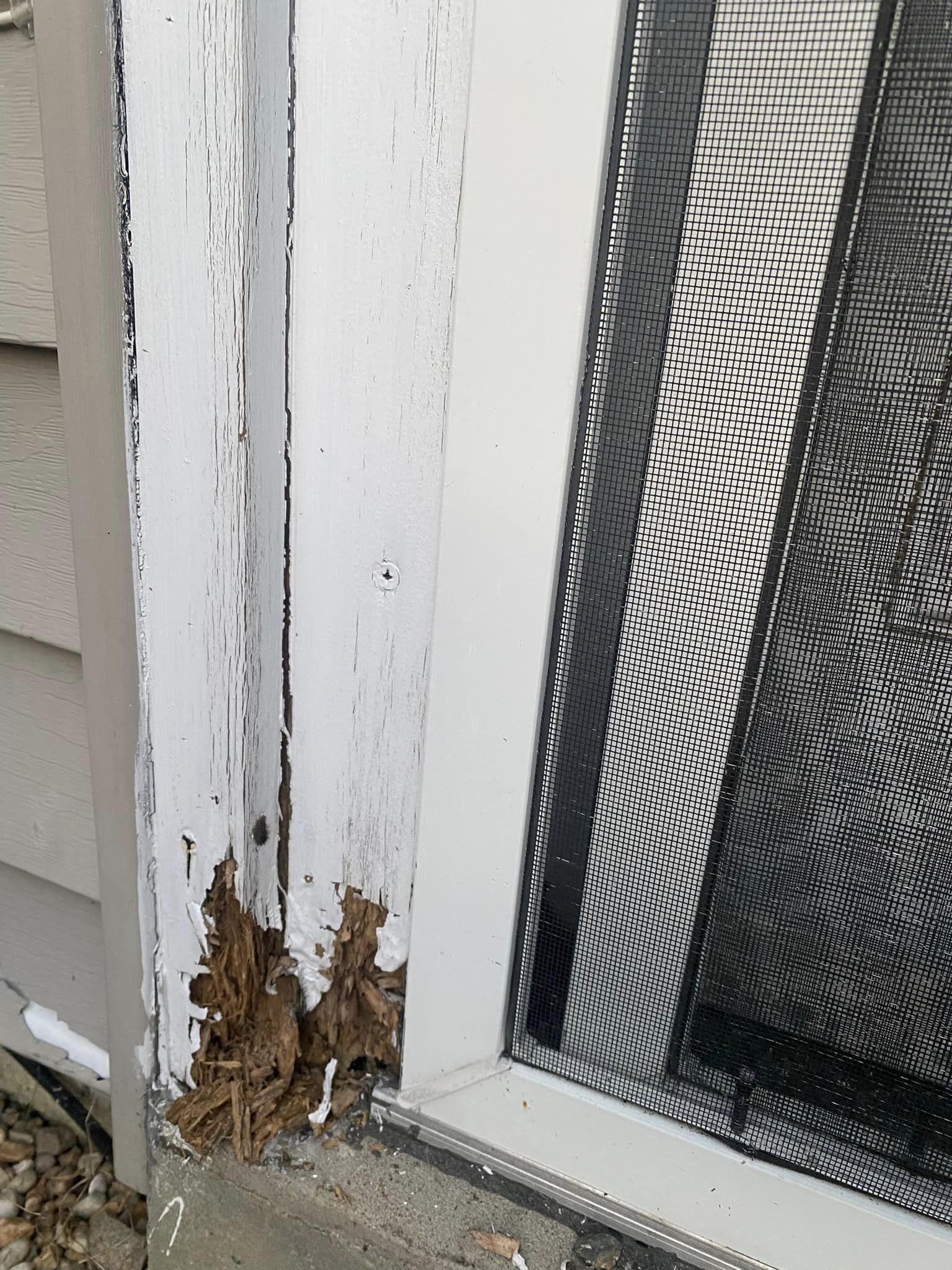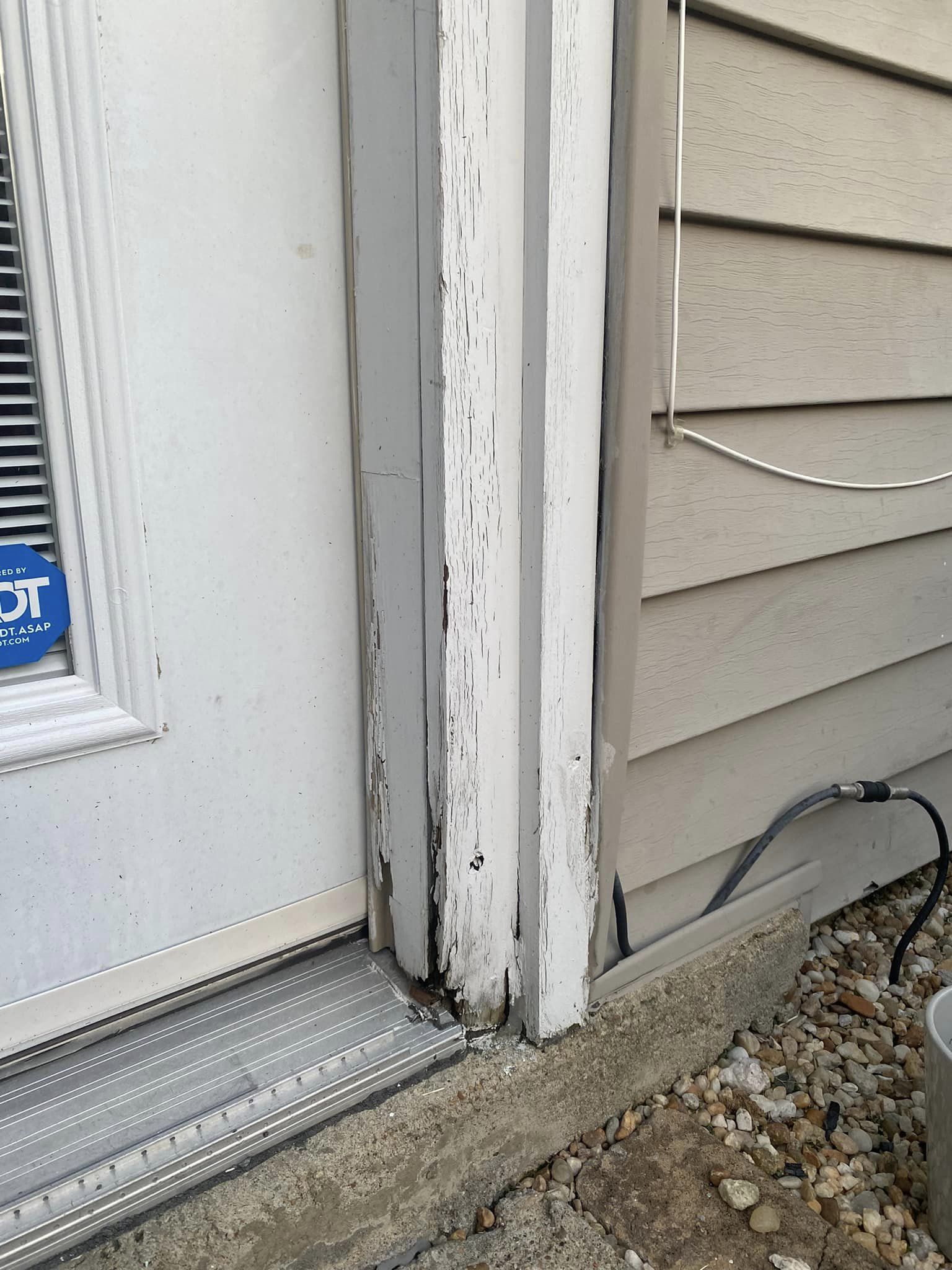What is the most efficient DIY solution for repairing the back door that we were advised to fix by the home inspector but have yet to address after owning the house for a year?
1 year ago
Last Updated: May 8, 2024
What do you think is the best way for us to tackle this? It’s the back door of our place. We’ve had the house for about a year now, and the home inspector mentioned we should fix it, but we never got around to it. I did take a look to see how bad it is, and it seems to be just the bottom on each side.


We’ve encountered the same problem before; my father recommended checking out this link: https://www.homedepot.com/p/BOSS-Rx-1-1-4-in-x-4-9-16-in-x-8-in-PVC-Jamb-Moulding-Door-Frame-Rot-Repair-Kit-48/322776357
Use standard automotive Bondo. Mold it to the desired shape, sand it down, apply primer, and paint the entire door frame
That’s decay. Remove the trim, replace, and paint. It’s quite simple!
Please avoid covering it up. Doing so will only prolong and exacerbate the issue.
Remove the decayed sections. Take out the entire lengths of decayed trim, find matching types and sizes at the hardware store, trim to fit, apply primer if not already primed, secure in place, seal with caulk, and paint.
I just finished fixing the brickmold on mine today. If it’s the door frame, consider rebuilding or replacing the door.
Here’s what you do: get a drill, unscrew everything, use a hammer and pry bar to remove the trim, buy new trim, cut it with a mitre saw for better angles. Check for rot in the framing. If it’s still strong, apply Kilz for protection. Paint the trim before hanging, and seal with caulk. The goal is to keep water out and increase water resistance. Best of luck!
Looks like it’s time for a new door. The rot seems extensive in the door jamb.
Seems like a common issue you’re facing. If the rot is confined to the bottom of the door frame, consider repairs rather than a full replacement. Here’s a simple step-by-step guide:
1. Remove rotted wood: Carefully use a chisel or pry bar to eliminate damaged parts of the door frame.
2. Treat remaining wood: Apply wood preservative to protect against future rot.
3. Cut new wood: Measure and cut a replacement piece to fit accurately. Ensure it matches the existing frame.
4. Install new wood: Secure the new piece in place using screws or nails.
5. Seal and paint: Caulk around the new piece for airtightness, then paint to blend with the frame.
You’ll require basic tools and materials such as a chisel, screws, wood preservative, and paint. A circular saw or handsaw can be used for cutting straight lines. Use a carpenter’s square or straight edge to ensure precise cuts. Safety glasses and ear protection are advised when using power tools. If you’re unsure, consider hiring a professional.
Brought to you by Lenddit 🛠️, the ultimate platform for tool lending and more. Explore our site and earn extra income by renting out your tools 💵.
http://www.Lenddit.com
Recommends using an oscillating tool for accuracy in cutting, ensuring a snug fit for the replacement wood
– Quality Guaranteed
We’re facing a similar problem with rotted door frames and the bottom part of the metal door. We’re thinking about installing a vinyl sliding door as a replacement.
You can find those parts at Lowe’s, have them cut to size, and paint them as needed.
I think cutting at an angle is better..because straight cuts are more noticeable, above the decay and replace it with new wood. My husband, who is a carpenter, did this for an interior doorway after our house was flooded overnight. The repair was barely visible. In fact, if you can cut through both pieces at once, you’ll get a seamless match. I also picked up this tip from a carpet installer. He placed the new piece to be connected on top of the other and cut through both.. They fit perfectly.
I think cutting at an angle could assist in directing the water to drain off. Plus, it might make the repair less noticeable.
I repaired the same issue at my dad’s place by using a blade to remove the soft wood, applying bondo to fill the damaged area, and then sanding and painting over it. It was a cost-effective and long-lasting solution.
It’s easier to just redo the entire frame instead of attempting to patch it. Trust me, it’s a straightforward process. Replacing it will likely take longer than a half-hearted repair.
Haha, I could have sworn these pictures were of my house. The back door is identical.
There is a new wood putty available that can be used to fill in after removing all the rot. After filling, sand and paint over it.
If it’s not a historic piece, it’s best to opt for pvc trim or hardi trim and replace it completely to prevent future issues.
It’s a good idea to take off the trim and check how extensive the damage is. You could be amazed to find that the water has seeped beneath the surface of the trim.
Yep, same thing happened to us. The subfloor directly under the door is in need of some serious repair/replacement.
Oh man, we ran into similar problems. It looks like the builders really dropped the ball on sealing up those doorways and openings
If you’re looking for a temporary solution, use bondo and apply new paint and caulking.
Or if you need a replacement. A well-done bondo job can last for years.
The same thing happened with our French doors and swapping it out was a breeze. We managed to get most of it done in just one day. The total cost came to around 700 bucks.
Did you have to purchase new doors too?
We completed . Everything arrived intact with the frame already connected.
I have tried the Bondo solution. I wouldn’t really suggest it for this situation. The damage is just too extensive. Carpentry. It’s not that hard. One of the most important steps is careful demolition. For those who opt for the Bondo method: cover a paint mixer or thin plywood with waxed paper and slide it under the area to apply Bondo. This makes it easier to apply Bondo right up to the waxed paper and deeper. It creates a nice clean line and is sturdy. Remove the waxed paper spacer and after a few days, apply caulk. Use backer rod when necessary. Caulking on concrete will be more water-resistant than Bondo. It prevents wicking action.
Just replace it. There’s no way to truly ‘fix’ that.
Noted!
Replace PVC trim to prevent future rot.